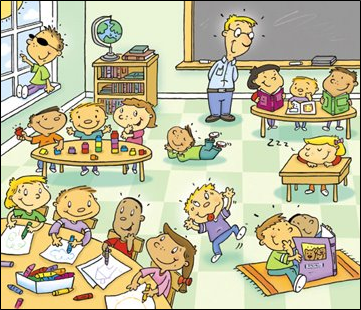
Children are easily susceptible to stressors of any kind. They can affect their ability to learn, solve assignments and participate in everyday classroom activities. These stressors can also influence their mental health, but the state of the classroom can weaken their immunity and expose them to various pulmonary and gastrointestinal diseases. These issues were addressed on many occasions, and in 2002 the World Health Organization launched the Healthy Environments for Children Alliance (HECA) publication, prepared to provide guidelines for schools to create healthy environments for children.
Turn the Classroom into a Welcoming Environment
Children respond to their surroundings, but they have also changed due to the modern age of smartphones and information availability. Nowadays a child expects a more vivid and inviting environment, they are not afraid to learn and ask for knowledge, and so gray walls and rows of desks may be a little outdated. Instead, consider making a different sitting arrangement with children positioned in a circle and facing each other as they would in a normal conversation. In this way, they will be encouraged to talk among themselves and discuss topics openly and without fear of giving the wrong answer or feeling uncomfortable with their peers.
Change the Colors Around Them
Colors are very important in everybody’s life, but children are especially sensitive to them. They more easily connect them to emotions, thus certain colors can create a positive environment for learning and being productive students. Purple, pink, blue, yellow and green with some embellishments like flowers, butterflies, clouds, and balloons, for example, are perfect for primary schools. They are subtle enough not to draw attention, but also enticing enough to create a positive and pleasant environment where children feel safe and invited to participate. This will be the environment your child wants to come back to and can’t wait to spend time in, and that all reflect on their willingness to learn and create.
A Clean Space is a Healthy Space
Children’s immune system is still in development and they often get sick. But besides seasonal conditions, there are those which can become permanent and chronic if enough attention is not paid to hygiene in the classroom. Daily cleaning is not enough to remove persistent dirt and allergens piling up in the crevices and on the cabinets. So at least once a month you should consider hiring professional services like or organize parents for more thorough and detailed cleaning of the classrooms. It should be pointed out that from 25% to 33% of overall children’s diseases are caused by environmental risk factors in developed and underdeveloped countries, according to WHO.
Completing all of the above will be useless if you don’t teach the children how to care for their health. One of the ways can be teaching them about the importance of washing their hands, eating healthy and sitting properly at their school desks. Another important thing may be showing them how to recognize when their classmate is feeling ill and how to help them. Teaching them this may save some child’s life because with some conditions it’s all about reaction time, like with asthma or allergic reactions. If some child suffers from a chronic disease or disability, they should be welcomed and accepted through open conversation and education on how to help them and not be afraid.
Children like being encouraged and they need incentives in order to feel comfortable to learn. But it’s very important to reach the balance between discipline and enjoyment. On one hand, you don’t want to be too strict and to create a fearful environment, and on the other, if you prove to be too lenient you will have chaos and discord. Try being motivational and supportive to create positive conditions and bridge the gap between the two. That way children will feel happy and accepted, which will increase their ability to solve problems and participate in class activities.
The WHO message, “The children of today are the adults of tomorrow. They deserve to inherit a safer and healthier world. There is no task more important than safeguarding their environment,” summarizes in a nutshell what the sole purpose of concentrating on better and improved conditions for schooling and educating young ones is. But before going wide, this has to be addressed on a smaller scale, starting with local communities and the school your children are attending, or where you work.
And if interested in learning how to help kids learn more from their homework assignments, visit our website.
This post comes from the TODAY Parenting Team community, where all members are welcome to post and discuss parenting solutions. Learn more and join us! Because we're all in this together.
